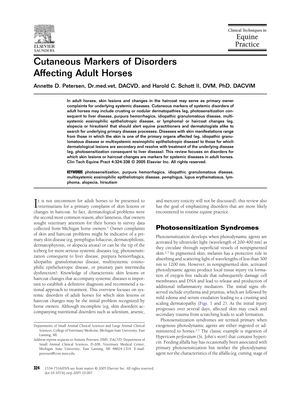Cutaneous Markers of Disorders Affecting Adult Horses
December 2005
in “
Clinical Techniques in Equine Practice
”

TLDR Skin and hair changes in horses can indicate serious diseases, and recognizing these signs is important for treatment and management.
The 2005 document reviews various skin and haircoat changes in adult horses as indicators of systemic diseases, emphasizing the importance for equine practitioners to recognize these signs for diagnosis and treatment. It discusses conditions such as photosensitization, often linked to liver disease, and immune-mediated diseases like purpura hemorrhagica, which has a high survival rate with aggressive treatment. The document also covers autoimmune skin diseases, with varying prognoses, and neoplastic diseases like cutaneous lymphoma, which may respond to treatment. Additionally, it addresses hypothyroidism, which is poorly documented but associated with dermatologic abnormalities, and pituitary pars intermedia dysfunction (PPID), or equine Cushing's disease, which is characterized by hirsutism and other systemic signs and can be managed with medication and care. The document provides insights into the diagnosis, treatment, and prognosis of these complex equine diseases, underscoring the need for thorough diagnostic evaluations in affected horses.
